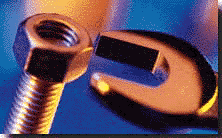



1. Ensure the battery is fully charged and in good condition. For safety
ensure the engine is cool or cold since spark plugs must be both removed
from the soft aluminium heads and themselves physically handled.
2. Remove all ignition leads by pulling on the boot top (not the lead) and
ALL the spark-plugs.
3. Locate the distributor on the right hand end of the front V6 bank. On
the inner upper edge of the distributor are two wiring harness connectors,
disconnect both these connectors. This prevents the coil being energised
and being damaged through having no spark plugs to discharge through.
Removal of the connectors is by pressing on the tap and pulling, removal
can be aided by first pressing the connectors closed first.
4. Locate the fuse box in front of the right strut tower and remove its
cover. Inside the left-bottom corner locate another white fuse cover
and remove. Directly below this second white fuse cover are a series
of fuses whose function is detailed in a schematic on the underside of
the fuse box. Remove the fuse marked "EGI Inj" to disable the fuel pump
to avoid oil dilution and lost compression through fuel wet piston rings.
6. Seated inside the car, verify the handbrake is fully applied and that
the gearbox is in Neutral. Fully depress the accelerator and turn the ignition
to "Start" and count a minimum of 7 cranks of the engine. Note the maximum
pressure reading on the compression guage. If fewer engine crankshaft rotations
are used, the pressure may not achieve the maximum the engine can provide.
A figure of 7 is chosen as arbitrarily usually sufficient & to allow uniform
comparison across the 6 cylinders.
7. Repeat this procedure for the next 6 cylinders.
9. Reconnect all six spark-plug leads and both distributor connectors. Refit
the "EGI Inj" fuse in the fuse-box & replace the two fuse-box covers.
10. Whilst performing the test ECU codes may have been set, to reset these
codes take a 10mm open spanner and remove the battery negative terminal.
Wait 2 minutes, open a passenger door and reconnect this terminal securely.
The engine will relearn idle over the next 20mins of driving, the test is
now completed.
On a 64k mile V6 engine, stone cold, dry, typical figures based on 7 crankshaft
rotations are 185-185-185psi on cylinders 1-3-5 & 185-190-190 on cylinders 2-4-6.
A warm engine will increase figures slightly, as will a higher number of
crankshaft rotations.
If figures are close to minimum, and adding a little oil to a cylinder brings
the pressure up then there is a ring problem. If pressure does not come up
then the problem is valves or valve-guides. Valve guide problems are usually
indicated by oily-wet spark plug electrodes (not plug threads, the electrodes).
Last Upload: 31st January, 2002. V1.50a
Compression Test Method - FI notes & figs (all)
 Tools Required
Tools Required
Tools required are compression guage with auto-hold facility, 220psi capability
with 14mm spark-plug fitment & extra long extension for rear spark plug holes; spark
plug wrench (Mazda car toolkit); 10mm open spanner.
 Getting Started
Getting Started
When performing a compression test the fuel & ignition system must be disabled.
Tightening torque of spark plug is 15-22Nm, 11-16lb/ft as in LOW for alloy heads.
 Performing the Test
Performing the Test
5. Carefully screw-in the compression guage to the #1 cylinder (top row
numbers 1-3-5 from left to right, bottom row is 2-4-6). Do not cross-thread
the guage, allow the gauge to seal via the O-ring but do not overighten.
Verify all other spark-plugs have been removed.
 Finishing
Finishing
8. When finished, refit all spark-plugs and tighten to the appropriate
torque (15-22Nm, 11-16lb/ft) but do not overtighten and do not cross-thread.
 Compression Data
Compression Data
Technical specification data for the V6 is 203psi maximum, 140psi minimum.
For the 2.0 figures are 171psi maximum, 119psi psi minimum.

URL: http://homepage.ntlworld.com/dorothy.bradbury/probemx/p_m16.htm